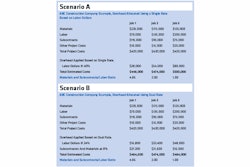It’s hard to believe but you have another year under your belt, and hopefully it was a profitable one. On the one hand, it’s exciting to see how the year end is going to turn out compared to your plans for 2014. On the other, it’s time to assess how 2014 went, mix in all the industry, location, economic and customer input you collected to date and complete the plan for 2015 and beyond. I find both scenarios exciting and challenging. You should too since it’s your company we’re talking about.
We have been through some confusing times with all the economic discussion — enough to drive you nuts. And even after listening and studying all you can from the talking heads, you still come away without a clear understanding how to manage your risk over the next 12 months.
I recently sat in on a presentation by Kenneth Simonson, chief economist for the Associated General Contractors of America. I figure if anyone has current input about your industry it’s this guy, and he did provide an understandable presentation about what and why things are happening the way they are in the construction world. Unfortunately, most of the slides showing projected revenues for 2015 were kind of flat lines — still some revenue growth, but not much. Growth in the 1% to 10% range seems to be the general consensus.
The areas of growth are the energy fields, work on ports as a result of the Panama Canal expansion and multifamily housing. There is also some additional activity in manufacturing and warehousing. The public sector seems to still be in recession mode. You can get a copy of the presentation to use when forming your 2015 plan by emailing Mr. Simonson at [email protected].
Review Your Organization
Since the industry seems to be doing better, it may be time to look over your operation. Take some time to study the balance sheet and what is in it and calculate your debt covenants to see how much wiggle room you have. Finally, do a performance review of the income statement to find ways to get the whole organization back into a “normal” status going forward.
There is little doubt most contractors had to make “adjustments” to get through the last five years. These adjustments now need to be reviewed and/or reversed if that in fact helps support the company mission.
If I had to suggest specific steps to take, they would include:
- Make sure you understand 2014’s results and any non-recurring transactions in ’14 that will not repeat in ’15.
- Spend time with team leaders to see what they see regarding 2015. You may also want to chat with some line folks to get their input as well.
- You should personally visit the customers that provide 80% of your revenue and ask what they anticipate for 2015 and how you can help. Run a report listing customer 2014 revenue to date and go from there. In fact, run a three-year comparison of that report to see who made the list and who fell off it.
- Review your credit and collection policies and update as necessary.
- Get a receivables list and go over it line by line to find out what all of those strange numbers mean. There are probably some bucks available on the list that you should get, or there may be customers on the list who should no longer be there. Believe me, an aggressive credit and collection policy pays for itself, saves a lot of time and keeps cash in the bank account.
- I hate to say it, but you really need to do a physical inventory of your parts and equipment to see what is there and what is missing. You may even be surprised to find there is more on hand than you have on the books (but don’t count on it). Now, get rid of the junk and 20-year-old parts you are never going to use and clean up the yard.
- Ask your HR department for an active employee list and compare those employees that generate income against those that don’t. Ask your peers to prepare a similar list so you can compare results. Calculate the percentage of income producers as a percentage of total staff, and use that calculation to see if you are overstaffed because procedures are out of date or systems are not being utilized properly. This is a simple step that can tell you a lot about your operation. The next time you ask yourself “how come ABC Company makes more money than we do,” the first place to look is this employee efficiency calculation. If you find you have five more non-revenue producers than ABC, you have a big part of the answer.
Get Control of Costs
A big issue for every contractor relates to equipment costs (both owned and rented), and how those costs get absorbed in jobs. This is another area where you want to compare your operating rates for both the equipment and operators to see if there are ways to get more efficient.
OEMs, dealers and contractors are all starting to use or are using telematics to help control costs, and it is working. You would be amazed to see how contractors are using this data to lower the costs of owning and operating equipment. Heck, tracking idle time alone can reduce costs to where it makes a difference. The point here is if your competitors aggressively use telematics, they will have more solid and most likely lower job costs they can rely on when bidding projects. If you want to keep your competitive advantage, using telematics is a must.
Ask your CFO for a cash flow statement similar to the one found in your annual audit report. How are you doing? There are three sections in that report: operations, investing and financing. Are you making money from operations or only because you’re selling off assets to cover the cash shortage?
All of this may take some time to digest. But if you do it, you will have a pretty good idea what to do to clean up the operation to be more efficient and generate additional cash flow — information you can add to your overall thinking about your budget and game plan for 2015.
There’s money in that data that’s yours for the taking. I would make this a quarterly function, because if folks know you are looking, things have a way of getting cleaned up before you see it. It’s magic!



















